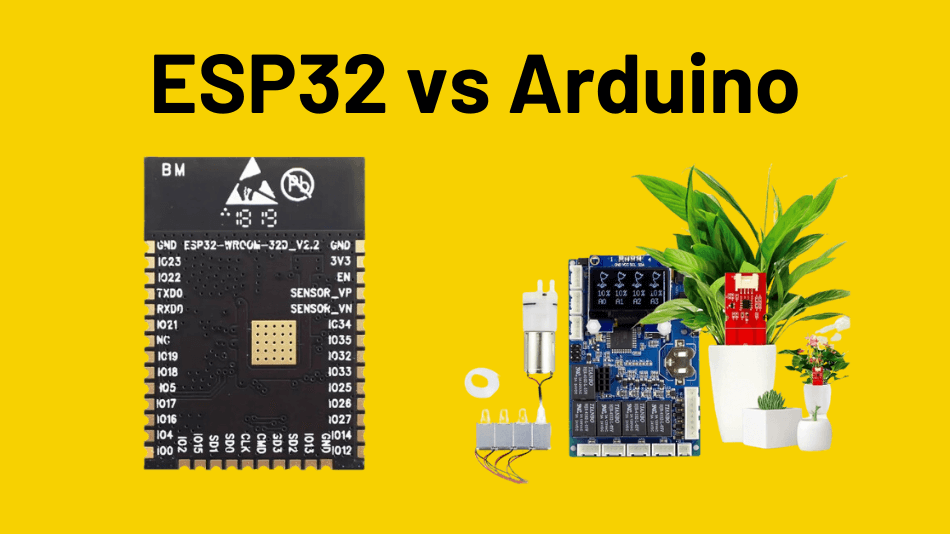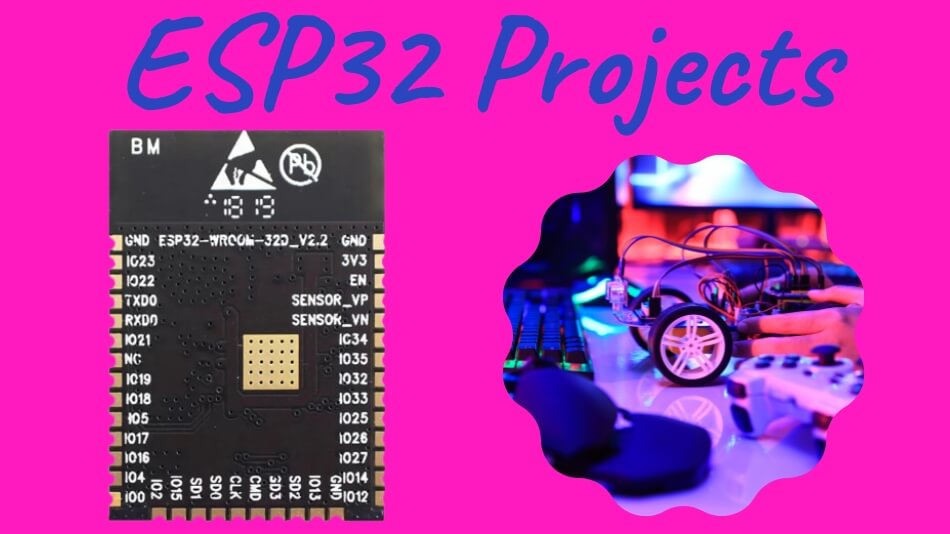Introduction

In microcontrollers and IoT, two names often spark curiosity and debate among enthusiasts and professionals alike: ESP32 and Arduino.
These platforms have transformed how we approach DIY electronics, robotics, and smart applications. But what sets them apart, and how do you choose between ESP32 vs Arduino for your next project? Let’s delve into this digital duel to uncover their unique features, strengths, and ideal use cases.
ESP32 vs Arduino: Understanding the Basics
What is ESP32?
Key Features of ESP32
- Dual-Core Processor: Enhanced processing power for complex tasks.
- Wi-Fi and Bluetooth Integration: Ideal for IoT applications.
- Greater Memory Capacity: Supports more extensive programs and data handling.
What is Arduino?
Key Features of Arduino
- User-Friendly Interface: Perfect for beginners in electronics.
- Wide Range of Models: Versatile options for different needs.
- Strong Community Support: Extensive resources and troubleshooting help.
Performance Comparison
When it comes to ESP32 vs Arduino, performance is a critical factor. Let’s break down how they stack up against each other.
Processing Power
- ESP32: Boasts a dual-core processor, offering higher computational speed.
- Arduino: Generally single-core, with varying speeds depending on the model.
Connectivity
- ESP32: Inbuilt Wi-Fi and Bluetooth make it a frontrunner for connected devices.
- Arduino: Requires additional shields for connectivity, adding complexity.
Memory and Storage
- ESP32: Larger RAM and flash memory, facilitating more extensive programs.
- Arduino: Limited memory, but sufficient for basic and intermediate projects.
Suitability for Projects
Choosing between ESP32 vs Arduino hinges on the nature of your project.
Ideal Projects for ESP32
- IoT Devices: Its connectivity features are a boon for smart devices.
- Complex Robotics: Handles sophisticated algorithms effectively.
- High-Data Applications: Ample memory supports data-intensive tasks.
Ideal Projects for Arduino
- Beginner Electronics: Its simplicity makes it great for learning basics.
- Prototyping: Quick and easy setup for testing concepts.
- Low-Power Projects: Consumes less power, suitable for battery-operated designs.
Ecosystem and Community Support
Both platforms boast vibrant communities, but there are differences.
ESP32’s Ecosystem
- Growing Community: Rapidly expanding with IoT’s rise.
- Resources: Increasing number of tutorials and forums for support.
Arduino’s Ecosystem
- Established Community: Decades of accumulated knowledge and resources.
- Versatility: A wide array of compatible shields and modules.
Cost and Accessibility
Cost can be a deciding factor in the ESP32 vs Arduino debate.
Pricing
- ESP32: Slightly higher priced but offers more features.
- Arduino: Generally more affordable, with a range of options.
Availability
- ESP32: Widely available but newer in the market.
- Arduino: Ubiquitous presence in electronics stores and online platforms.
Delving Deeper into the Technicalities
Advanced Features of ESP32
The ESP32 goes beyond essential microcontroller functions. It offers:
- Analog to Digital Converters (ADCs): Higher resolution ADCs for precise sensor readings.
- Peripheral Interfaces: Includes SPI, I2C, UART, CAN, and more.
- Energy Efficiency: Enhanced power management features for IoT devices.
Arduino’s Advanced Capabilities
Despite its simplicity, Arduino has advanced facets:
- Shield Compatibility: Custom shields expand their capabilities.
- PWM Channels: Useful for controlling motors and LEDs.
- Cross-Platform IDE: Arduino IDE is versatile, supporting various operating systems.
Programming Environment and Language
ESP32’s Development Frameworks
- ESP-IDF: The official development framework of ESP32, using C and C++.
- Arduino Core for ESP32: Enables using Arduino IDE for programming ESP32.
- MicroPython Support: For developers preferring Python.
Arduino’s Programming Interface
- Arduino IDE: A straightforward, beginner-friendly environment.
- Language: Uses a variant of C++, easy to learn for beginners.
- Comprehensive Support for Libraries: Extensive libraries simplify coding for various modules.
Real-World Applications and Case Studies
Innovative Uses of ESP32
- Smart Home Systems: Leveraging its Wi-Fi capabilities for home automation.
- Wearable Health Devices: Utilizing its compact size and Bluetooth for health monitoring.
Arduino in Action
- Educational Tools: Widely used in schools for teaching electronics and coding.
- DIY Projects: From simple LED displays to more complex robots.

Future-Proofing and Scalability
ESP32’s Roadmap
- IoT Focus: Continually evolving to meet the demands of IoT development.
- Firmware Updates: Regular updates to enhance functionality and security.
Arduino’s Longevity
- Time-Tested Reliability: Proven track record in various applications.
- Community Contributions: Ongoing development of new shields and libraries.
Troubleshooting and Technical Support
ESP32’s Support Channels
- Online Forums: Active communities on Reddit, Stack Overflow, and dedicated forums.
- Documentation: Comprehensive guides and API documentation.
Arduino’s Troubleshooting Avenues
- Vast Online Community: A wealth of forums, YouTube tutorials, and blogs.
- Official Documentation: Detailed guides and FAQs on the Arduino website.
Final Thoughts: Which One Wins?
When considering ESP32 vs Arduino, it’s crucial to understand that the concept of a “winner” is subjective and entirely depends on your project’s specific needs and context.
ESP32: The Advanced Contender

- Best for IoT and Advanced Projects: If your project demands high-speed processing, Wi-Fi and Bluetooth connectivity, and large memory capacity, ESP32 is the superior choice. It’s ideal for complex IoT applications, smart home devices, and advanced robotics.
- Future-Proof: With its advanced features and regular firmware updates, ESP32 is more future-proof, especially for projects that require connectivity and scalability.
Arduino: The Accessible Champion
- Ideal for Beginners and Education: Arduino’s simplicity, extensive community support, and ease of use make it the go-to option for beginners, educators, and hobbyists. It’s perfect for learning the basics of electronics and programming.
- Versatility and Affordability: With a wide range of models and the availability of numerous shields, Arduino offers excellent versatility. It’s also generally more affordable, making it a budget-friendly option for many.
The Verdict
There is no clear winner in the ESP32 vs Arduino comparison. Each has unique strengths and is best suited for different projects. The choice boils down to the project’s requirements, your budget, and your expertise level in electronics and programming.
- For advanced, connected, and data-intensive projects, ESP32 is the better choice.
- Arduino is ideal for educational purposes, more straightforward projects, and those on a tight budget.
In summary, both ESP32 and Arduino offer valuable and distinct capabilities. Your decision should be based on carefully assessing your project’s needs and personal or organizational goals. Whichever you choose, both platforms open doors to a world of creativity and innovation in electronics and IoT.
Frequently Asked Questions

What is the main difference between ESP32 and Arduino?
Answer: The main difference lies in their capabilities. ESP32 is more potent with a dual-core processor, built-in Wi-Fi and Bluetooth, and more significant memory, making it suitable for advanced IoT projects. On the other hand, Arduino is more straightforward and user-friendly, ideal for beginners and basic electronics projects.
Can I use Arduino IDE to program ESP32?
Answer: You can use the Arduino IDE to program ESP32 by installing the ESP32 board add-on. This allows you to leverage the familiar Arduino programming environment while utilizing ESP32’s advanced features.
Is ESP32 more expensive than Arduino?
Answer: Generally, ESP32 is slightly more expensive than many Arduino models due to its advanced features like Wi-Fi and Bluetooth capabilities and more significant memory. However, the price difference is unimportant and should be weighed against the requirements of your project.
Can Arduino handle IoT projects?
Answer: Arduino can handle basic IoT projects but requires additional modules or shields for connectivity. ESP32, with its built-in Wi-Fi and Bluetooth, is more suitable for more complex IoT applications.
Is ESP32 suitable for beginners?
Answer: ESP32 can be more challenging for beginners due to its advanced features. However, with some basic programming knowledge and a willingness to learn, beginners can undoubtedly start with ESP32, especially if their projects require specific features.
Which has better community support, ESP32 or Arduino?
Answer: Arduino has a larger and more established community due to its extended presence in the market. However, ESP32’s community is rapidly growing, especially among developers focused on IoT and advanced applications.
Conclusion

In the ESP32 vs Arduino comparison, it’s evident that both platforms have their unique strengths and cater to different needs. ESP32 stands out for advanced projects, especially those requiring connectivity and significant processing power. It’s a robust choice for IoT applications and complex tasks. On the other hand, Arduino shines in its simplicity and accessibility, making it an excellent option for beginners, educators, and hobbyists.
The decision between ESP32 and Arduino should be driven by your project’s specific requirements, budget, and experience level. While ESP32 offers advanced features, Arduino brings ease of use and a vast support community. Whichever you choose, both platforms provide immense potential for innovation and creativity in electronics and IoT projects.

